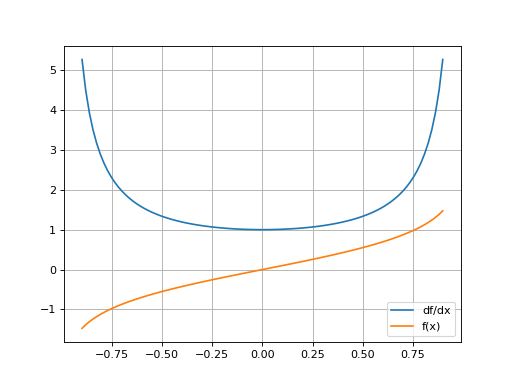mygrad.arctanh#
- class mygrad.arctanh(x: ArrayLike, out: Tensor | ndarray | None = None, *, where: Mask = True, dtype: DTypeLikeReals = None, constant: bool | None = None)#
Inverse hyperbolic tangent, element-wise.
This docstring was adapted from that of numpy.arctanh [3]
- Parameters:
- xArrayLike
Input tensor.
- outOptional[Union[Tensor, ndarray]]
A location into which the result is stored. If provided, it must have a shape that the inputs broadcast to. If not provided or None, a freshly-allocated tensor is returned.
- constantOptional[bool]
If
True, this tensor is treated as a constant, and thus does not facilitate back propagation (i.e.constant.gradwill always returnNone). Defaults toFalsefor float-type data. Defaults toTruefor integer-type data. Integer-type tensors must be constant.- whereMask
This condition is broadcast over the input. At locations where the condition is True, the
outtensor will be set to the ufunc result. Elsewhere, theouttensor will retain its original value. Note that if an uninitialized out tensor is created via the defaultout=None, locations within it where the condition is False will remain uninitialized.- dtypeOptional[DTypeLikeReals]
The dtype of the resulting tensor.
- Returns:
- outTensor
Tensor of the same shape as x.
Notes
arctanh is a multivalued function: for each x there are infinitely many numbers z such that tanh(z) = x. The convention is to return the z whose imaginary part lies in [-pi/2, pi/2].
For real-valued input data types, arctanh always returns real output. For each value that cannot be expressed as a real number or infinity, it yields
nanand sets the invalid floating point error flag.The inverse hyperbolic tangent is also known as atanh or
tanh^-1.References
[1]M. Abramowitz and I.A. Stegun, “Handbook of Mathematical Functions”, 10th printing, 1964, pp. 86. http://www.math.sfu.ca/~cbm/aands/
[2]Wikipedia, “Inverse hyperbolic function”, https://en.wikipedia.org/wiki/Arctanh
[3]Retrieved from https://numpy.org/doc/stable/reference/generated/numpy.arctanh.html
Examples
>>> import mygrad as mg >>> mg.arctanh([0, -0.5]) Tensor([ 0. , -0.54930614])
(Source code, png, hires.png, pdf)

- Attributes:
- identity
- signature
Methods
accumulate([axis, dtype, out, constant])Not implemented
at(indices[, b, constant])Not implemented
outer(b, *[, dtype, out])Not Implemented
reduce([axis, dtype, out, keepdims, ...])Not Implemented
reduceat(indices[, axis, dtype, out])Not Implemented
resolve_dtypes(dtypes, *[, signature, ...])Find the dtypes NumPy will use for the operation.
- __init__(*args, **kwargs)#
Methods
__init__(*args, **kwargs)accumulate([axis, dtype, out, constant])Not implemented
at(indices[, b, constant])Not implemented
outer(b, *[, dtype, out])Not Implemented
reduce([axis, dtype, out, keepdims, ...])Not Implemented
reduceat(indices[, axis, dtype, out])Not Implemented
resolve_dtypes(dtypes, *[, signature, ...])Find the dtypes NumPy will use for the operation.
Attributes
identitynargsninnoutntypessignaturetypes